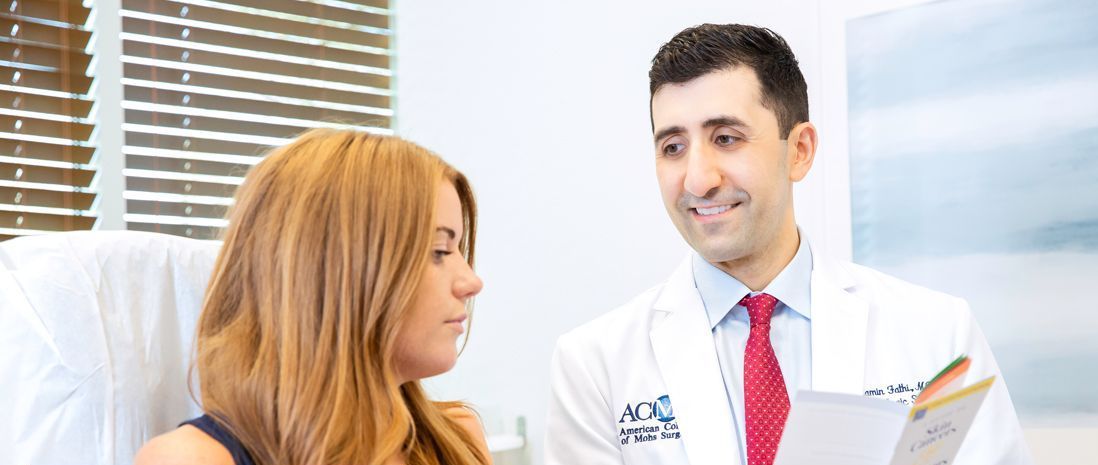Your Mohs Surgery Day
Get peace of mind with a clear, step-by-step guide to your Mohs procedure at Phoenix Surgical Dermatology Group.
Your Mohs Surgery Day: What to Expect at Phoenix Surgical Dermatology Group
At Phoenix Surgical Dermatology Group, we believe that preparation and understanding are key to achieving the best outcomes from Mohs Micrographic Surgery, one of the most effective treatments for nonmelanoma skin cancer. Our team is committed to providing compassionate care, clear communication, and a supportive environment throughout your treatment process.
Here’s what you can expect on the day of your
Mohs surgery, including how to prepare and what happens before, during, and after your procedure.
Before Your Mohs Surgery
1. Consultation with Your Mohs Surgeon
Prior to your Mohs procedure, you will meet with your board-certified, fellowship-trained Mohs surgeon. This consultation is your opportunity to:
- Ask any questions or express concerns about the procedure
- Review your medical history and discuss any medications or supplements you are currently taking
- Understand the risks, benefits, and expected outcomes of Mohs surgery
- Discuss whether Mohs surgery is the best treatment option for your skin cancer
2. Medications
Inform your surgeon of all medications, including prescription drugs, over-the-counter medications, supplements, and herbal remedies.
You will be advised on which medications to continue and which to temporarily stop before surgery.
3. Food and Drink
Unless instructed otherwise (especially if you are scheduled for plastic or oculoplastic surgery the same day), you may eat and drink normally before your procedure.
4. Clothing Recommendations
Wear comfortable, loose-fitting clothing that is easy to remove if needed.
Avoid tight collars, turtlenecks, or restrictive sleeves, particularly if surgery will be performed on the head, neck, or arms.
5. Transportation
Arrange for a responsible adult to drive you home after the procedure, especially if your surgery involves sensitive areas like the eyes, nose, or multiple cancer sites.
You may feel tired, or the bandages may affect your ability to drive safely.
The Day of Your Mohs Surgery
Arrival at the Clinic
- Please arrive 15 minutes early for your scheduled appointment.
- Upon arrival, we will take
preoperative photographs and begin
numbing the area with local anesthesia.
Length of the Procedure
- Plan to spend
several hours at the clinic.
- The duration depends on factors such as the
size, depth, location, and number of tumors being treated.
- More complex or multiple tumors may require extended time.
Waiting Between Stages
- After each tissue removal, the specimen is processed and examined under a microscope to confirm whether any cancer cells remain.
- This analysis takes time, and
waiting between stages is common.
- We recommend bringing reading material, a tablet, or other activities to help pass the time comfortably.
Amenities for Your Comfort:
- Complimentary snacks and beverages available in the waiting area
- Guest Wi-Fi access so you can stay connected during your visit
- You are welcome to bring a guest, though guests will be asked to wait in the waiting area during the surgical portion of the procedure.
After Your Mohs Surgery
Post-Operative Instructions
- Once your surgery is complete, your Mohs surgeon will provide you with detailed wound care instructions. These will include guidelines on:
- How to clean the wound
- When and how often to change the dressing
- Which activities to avoid during the healing process
- Pain management and infection prevention
Follow-Up Care and Additional Procedures
- If your reconstruction will be completed by another specialist, such as a plastic or oculoplastic surgeon, that physician will serve as your main point of contact for follow-up care.
- If your Mohs surgeon handles both the removal and reconstruction, we will schedule your follow-up visit directly with our clinic.
Expected Recovery Experience
- Some discomfort, swelling, and redness are common at the surgical site.
- Your surgeon may recommend over-the-counter pain relievers, such as acetaminophen (Tylenol) or ibuprofen (Advil, Motrin).
- Healing timelines vary depending on the size and location of the defect, but most patients experience significant healing within a few weeks, with
scars continuing to improve over several months.
Frequently Asked Questions About Reconstructive Surgery After Mohs
Can I eat and drink before Mohs surgery?
Yes, unless you are scheduled for plastic or oculoplastic reconstruction under sedation, you may eat and drink as normal before your surgery.
How long will Mohs surgery take?
Mohs surgery typically lasts 3 to 5 hours, though complex cases may require more time. The majority of the time is spent processing and analyzing the tissue to ensure complete cancer removal.
Can I drive myself home after Mohs surgery?
It is recommended to arrange transportation home, especially if surgery is performed near the eyes, on the face, or if you have large or multiple tumor sites.
Will I have a scar after Mohs surgery?
Yes, all surgeries result in some degree of scarring. However, Mohs surgery minimizes tissue removal, and reconstruction techniques are used to optimize cosmetic results.
What should I bring on the day of my surgery?
- Insurance card and photo ID
- A list of medications
- A book, tablet, or other quiet activities
- Comfortable clothing
- A snack if desired, although complimentary refreshments are available
Schedule Your Mohs Surgery Consultation Today
At Phoenix Surgical Dermatology Group, we are committed to providing expert skin cancer care with a focus on your comfort, safety, and the best possible outcomes. If you have been diagnosed with skin cancer or referred for Mohs Micrographic Surgery, contact us today to schedule your consultation and learn more about what to expect.
Your health and peace of mind are our priority. Let our experienced team guide you every step of the way.





